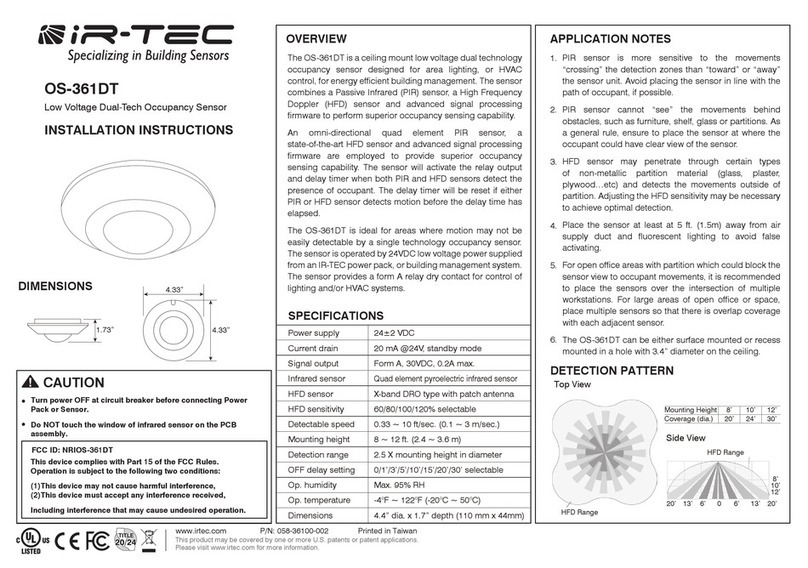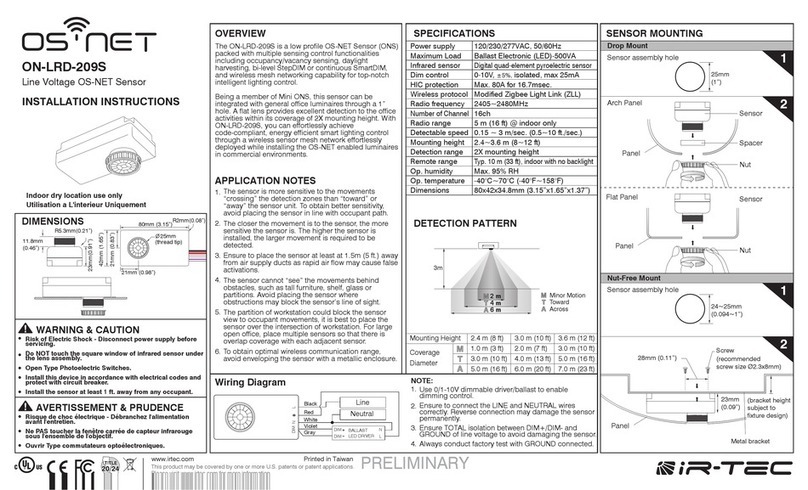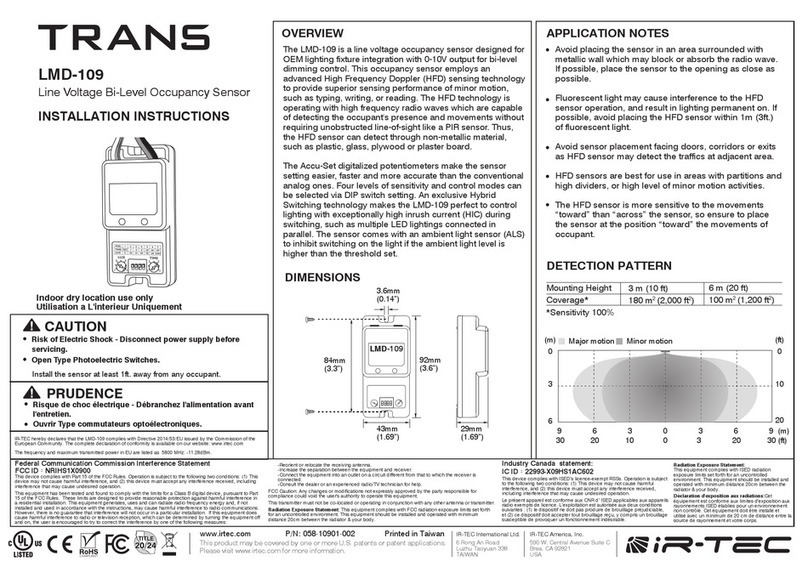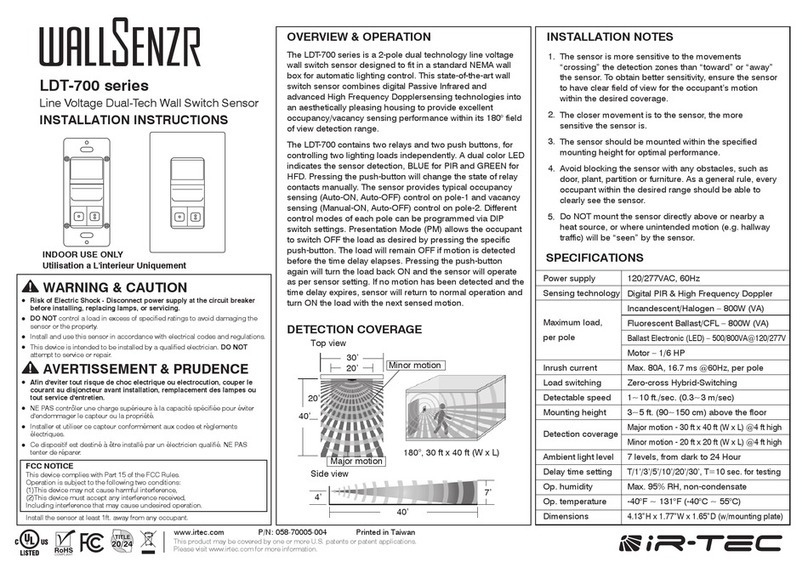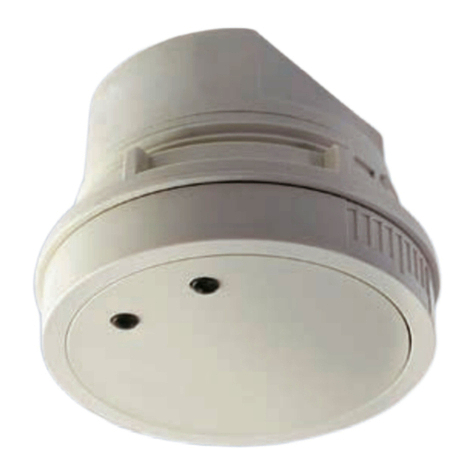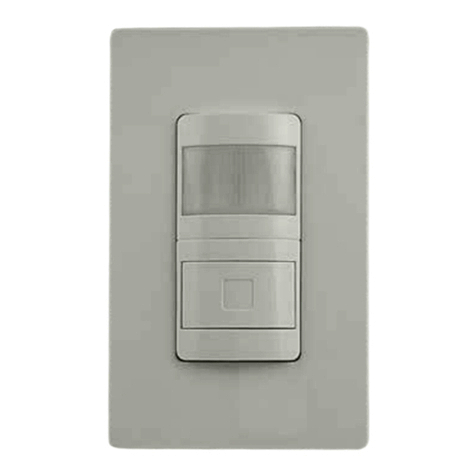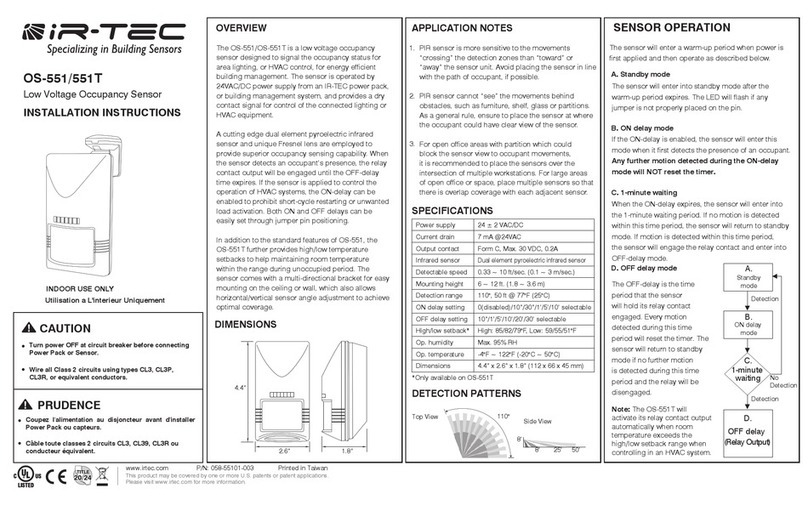
INSTALLATION
TESTING
Ensure the power has been turned OFF at the circuit breaker.
Prepare all wires with adequate length (cut the excessive
length if necessary) and properly striped.
Connect the wires of sensor with line voltage power and LED
driver ballast as the wiring diagram shown.
Carefully manage the wires to allow the sensor being
mounted in the wall box with screws. Do NOT use excessive
force when installing the sensor into the wall box as this
could bend the mounting plate and affect button operation.
Turn the circuit breaker ON. Refer to the TESTING section
and conduct sensor test if necessary. Snap-on the cover plate
after sensor test and setting complete.
1.
2.
4.
3.
5.
Apply power to the sensor*. Wait for the sensor to warm-up
(GREEN LED will blink during warm-up period).
*The connected light will be switched on as delay time set
(factory default 10 minutes) after the power applied. To speed
up the test, you may set the TIME potentiometer to position 1
(T) for shortest delay (10 seconds).
Walk within the desired range and observe the sensor LED
indication (GREEN blinks per 2 seconds to indicate PIR
detecting and BLUE blinks to indicate HFD detecting). Walk
outside of the desired range and observe if the HFD sensor
can detect the movement. If BLUE still blinks, reduce the HFD
sensitivity via DIP switch setting accordingly.
Replace the cover plate after testing and setting completed.
Do NOT forget to set the TIME at the desired position for
optimum delay after test.
1.
2.
3.
WIRING DIAGRAM
After installation complete, it is recommended to conduct
sensor test as instructed below;
BUTTON OPERATION
Button operations allow the user to change
the ON-OFF status, temporarily adjust the
lighting level as desired, or memorize the
preferred level for the next presence.
Potentiometer
Sensor
Red
DIM+
0-10V Driver/Ballast
L
DIM N
Black
Line
120/277VAC
Green-Yellow
Gray
Violet
Ground
White
Neutral
LUX
1 7
2 6
3 5
4
TIME
1 7
2 6
3 5
4
LUX
TIME T
POS. 1 2 3 4 5 6 7
1’ 3’ 5’ 10’ 20’ 30’
10 20 35 50
100 150 24H
Factory Set
Connect the
GREEN-YELLOW wire to
the GROUND for safety.
NOTE:
To program the sensor control
mode or change the settings,
press the push-button cover and
slide it down as shown.
SETTING
Slide ON
1 2 3 4 5
TIME
LUX
Press
&
DIP
Switch
ON
1 2 3 4 5
TIME
LUX
LUX setting determines the threshold of ambient light level
that sensor will inhibit switching on the light. Factory set is
pointing at position 7 which allows sensor to switch on the
light anytime. Set the arrowhead to point different positions
for different ambient light level thresholds.
LUX – Ambient light level
TIME setting determines the delay time that sensor will hold
the light on after the last motion detected. Factory set is at 10
minutes and different times can be set by pointing the
arrowhead to different positions. NOTE: Set at position 1 will
shorten the delay to 10 seconds for 10 minutes. The delay
time will resume to 10 minutes if the potentiometer has not
been set to other position.
TIME - Delay time
4 levels of HFD sensitivity can be set
through different combinations of SW1 & 2.
DIP Switch
Switch #3 determines the operating
sensing technology of sensor. Setting it at
OFF position will disable the PIR sensor.
- SW5
Button Function Control
DUAL
HFD
ON
1 2 3 4 5
ON
1 2 3 4 5
ON
1 2 3 4 5
ON
1 2 3 4 5
Occ.
Vac.
ON
1 2 3 4 5
ON
1 2 3 4 5
ON/OFF
PM
Switch #4 sets the LDD-700 as an
occupancy sensor (factory default) or
vacancy sensor (SW4 is OFF).
Occupancy sensor – The sensor will turn on the light when PIR
detects the presence of an occupant, and turn the light OFF
automatically if no occupant activity has been detected by either
PIR or HFD sensor before the time delay elapses.
Vacancy sensor – Requires user to press any button of the
sensor to turn ON the light, and sensor will turn OFF the light
automatically if no occupant activity has been detected by either
PIR or HFD sensor before the time delay elapses.
Switch #5 determines the button
function control if the sensor is set as
an occupancy sensor (SW4 is ON).
ON/OFF (Manual Override) – Pressing ANY push-button will
turn OFF the load immediately and hold off until the button is
pressed again.
PM (Presentation Mode) – If PM mode is enabled (SW5 is
OFF), pressing any push-button will turn OFF the lights
immediately and hold off even with motion detected. Pressing
the push-button again will turn ON the lights and sensor
resumes its normal control. If no occupant activity is detected
before the delay time elapses, the sensor will resume its
normal control which means it will turn ON the light with the
next motion detected.
ON
1 2 3 4 5
ON
1 2 3 4 5
ON
1 2 3 4 5
ON
1 2 3 4 5
A short press on ANY button of an operating sensor will
change the ON-OFF status of controlled lighting.
NOTE: If the sensor is set as a vacancy sensor (SW4 at OFF)
and LUX is not at position 7, pressing the button will NOT turn
on the light if the ambient light level is HIGHER than the
threshold set.
Change the ON-OFF status
Press and hold the RIGHT button will continuously ramp the
lights up to the highest 100% (LED blinks in GREEN).
Intermittent press will increase the level step by step.
Press and hold the LEFT button will continuously dim the
lights down to the lowest 10% (LED blinks in BLUE).
Intermittent press will decrease the level step by step.
1.
2.
A long press on ANY button (>0.5 second) will enter into
Manual Dimming mode.
Adjust the lighting level
Press and hold BOTH buttons under Manual Dimming mode
until sensor LED indicates in Blue continuously.
Release both buttons, the LED will blink for 10 seconds and
sensor will save the current value as preferred level.
The controlled lights will flash ON and OFF for two times to
indicate saving complete.
1.
2.
3.
Memorize the preferred level
HFD Sensitivity - SW1 & 2
- SW3
Operating Sensor
- SW4Occupancy/Vacancy Sensor Selection
FADE
DOWN
RAMP
UP
LEFT RIGHT
